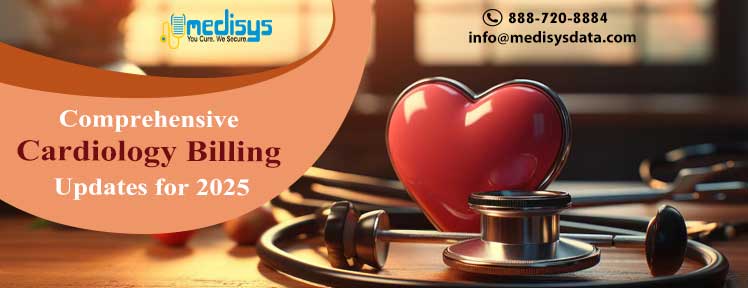The field of cardiology is constantly evolving, with advancements in technology and treatment options. These advancements necessitate changes in how cardiovascular services are billed and coded. In 2025, several key updates have significant implications for cardiology practices. This article talks about these changes in detail, providing practical guidance for cardiologists and their billing teams.
1. CPT Code Updates
Evaluation and Management (E/M) Services:
The 2025 CPT code set brought significant changes to E/M coding, particularly in the realm of telehealth.
- Synchronous Audio-Video Visits: New codes (e.g., 98000-98003) were introduced for synchronous audio-video telehealth visits. For example, a brief, 15-minute audio-video consultation with a patient for a medication adjustment would likely be coded using 98000.
- Audio-Only Visits: Codes such as 98008 were introduced for synchronous audio-only consultations, expanding billing opportunities for telephone consultations. For example, a brief phone call with a patient to address a minor medication side effect could be coded using 98008.
Accurate documentation is crucial. Providers must clearly document the type of telehealth service provided (audio-video or audio-only), the patient’s location, the nature of the encounter, and the medical decision-making involved.
Emerging Technologies:
The 2025 CPT code set introduced several new Category III codes for emerging cardiovascular procedures and technologies. A few examples are as follows:
- Transcatheter Aortic Valve Replacement (TAVR) with a novel bioprosthesis: A new Category III code may have been introduced for a specific type of TAVR using a newly developed bioprosthesis. This allows for data collection and evaluation of the safety and efficacy of this new technology.
- Robotic-assisted cardiac surgery using a specific surgical system: A new Category III code may have been introduced for robotic-assisted coronary artery bypass grafting (CABG) performed using a particular robotic surgical system.
These temporary codes are essential for tracking the utilization and outcomes of new procedures. Data collected using these codes helps inform future research and may ultimately lead to the development of permanent CPT codes for these innovative treatments.
Cardiac Contractility Modulation Systems:
Permanent CPT codes were introduced for cardiac contractility modulation system procedures, reflecting the growing use of this technology in managing heart failure patients. Cardiologists and their billing teams must be familiar with these new codes to ensure accurate billing and reimbursement for these procedures.
2. Medicare Physician Fee Schedule (PFS) Adjustments
The 2025 Medicare Physician Fee Schedule saw a modest decrease in the conversion factor, impacting reimbursement for most physician services, including those provided by cardiologists. The practical implications of these PFS adjustments are as follows:
- Increased Efficiency: Practices should focus on improving efficiency and reducing administrative costs to offset the impact of the reduced conversion factor.
- Value-Based Care: Participating in value-based care programs and demonstrating high-quality, cost-effective care can help mitigate the impact of reduced reimbursement.
- Bundled Payments: Explore participation in bundled payment arrangements, where providers are paid a single payment for a group of related services, which can improve care coordination and potentially increase revenue.
3. Telehealth Integration and Remote Patient Monitoring (RPM)
Telehealth has become an integral part of cardiovascular care delivery, enhancing patient access and improving convenience. The practical implications of telehealth integration are as follows:
- Optimize Telehealth Workflow: Develop efficient workflows for scheduling, conducting, and documenting telehealth visits.
- Patient Education: Educate patients on how to use telehealth technologies effectively and ensure they have the necessary equipment and internet access.
- Data Security and Privacy: Ensure compliance with HIPAA regulations regarding patient data security and privacy during telehealth encounters.
New CPT Codes for RPM Services
RPM plays a crucial role in managing chronic cardiovascular conditions. New CPT codes were introduced to facilitate billing for Remote Patient Monitoring (RPM) services, including:
- Device setup and patient education: This includes instructing patients on how to use the RPM device and interpreting initial data.
- Data analysis and interpretation: This involves reviewing and analyzing the data transmitted from the RPM device, identifying any potential issues, and making appropriate clinical decisions.
- Patient-physician communication: This includes communication with patients regarding their RPM data, addressing any concerns, and making necessary adjustments to their treatment plan.
Accurate documentation of RPM services, including the time spent on each component, is crucial for ensuring proper reimbursement.
4. ICD-10-CM Updates and Quality Measures
The 2025 ICD-10-CM coding system included several updates:
- New Codes: New codes were introduced for emerging cardiovascular conditions such as specific types of heart failure with preserved ejection fraction (HFpEF).
- Revised Codes: Existing codes were revised to reflect advancements in medical knowledge. For example, the codes for atrial fibrillation may have been revised to include more specific sub-types, such as persistent atrial fibrillation or paroxysmal atrial fibrillation.
Ongoing training for coding and billing staff on the latest ICD-10-CM updates is crucial to ensure accurate coding and avoid potential denials. Conduct regular internal coding audits to identify and correct any coding errors.
Conclusion
The evolving landscape of cardiology necessitates a proactive approach to billing and coding. By staying informed about the latest CPT code updates, understanding the impact of PFS changes, and adapting to the growing role of telehealth and RPM, cardiology practices can ensure accurate reimbursement, improve patient care, and navigate the complexities of the changing healthcare environment.
About Medisys
Medisys Data Solutions (MDS) offers expert cardiology billing and coding services, including:
- CPT and ICD-10-CM coding expertise
- Revenue cycle management
- Telehealth billing and reimbursement
By partnering with Medisys, cardiology practices can streamline their revenue cycle, maximize reimbursement, and focus on providing high-quality patient care. Contact us today for a free consultation!
CPT is a registered trademark of the American Medical Association. All CPT codes referenced in this article are copyrighted content.












